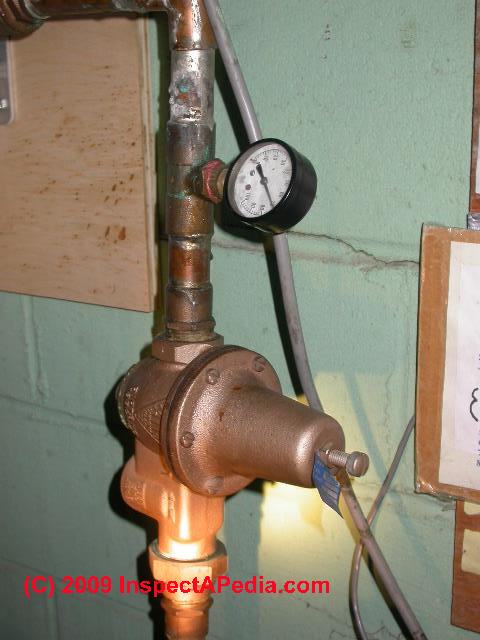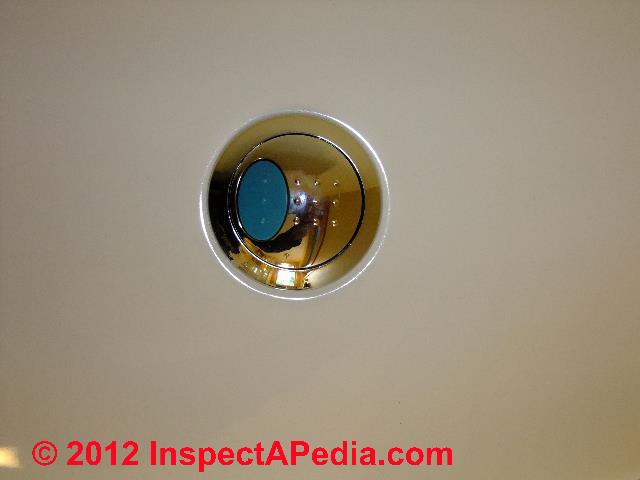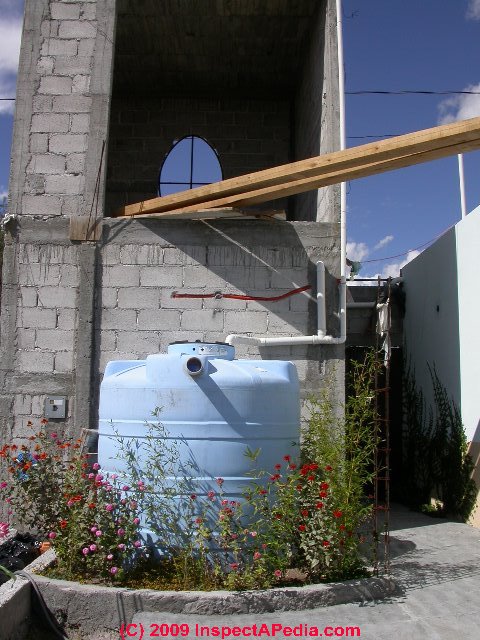 Water Sources, Water Conservation Choices
& Techniques
Water Sources, Water Conservation Choices
& Techniques
How to Save Water, Store Water, Find More Water for Drinking or Irrigation
- POST a QUESTION or COMMENT about methods to reduce water consumption & to find alternative water sources
Water sources & water conservation & use:
How to obtain, conserve & use water efficiently & how to find & store water for use in buildings.
This article lists suggestions for water conservation in or around buildings through a very wide range of approaches such as equipment choices, plumbing leak detection & repairs, water saving fixtures, water use conservation, and finding alternative sources for water supply & water storage.
InspectAPedia tolerates no conflicts of interest. We have no relationship with advertisers, products, or services discussed at this website.
- Daniel Friedman, Publisher/Editor/Author - See WHO ARE WE?
An Enormous Number of Ways to Save Water, Store Water, Find More Water - some quite easy
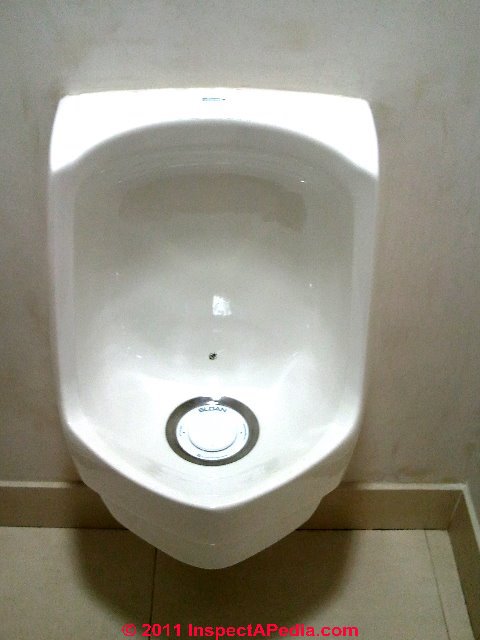 While some politicians and other interested parties continue to debate the rate of global warming and its effects on the availability of water world wide, in the U.S. the Grand Canyon water levels are returning to their historic and lower levels that are likely to remain below what the Canyon saw during the past 100 years.
While some politicians and other interested parties continue to debate the rate of global warming and its effects on the availability of water world wide, in the U.S. the Grand Canyon water levels are returning to their historic and lower levels that are likely to remain below what the Canyon saw during the past 100 years.
The New York Times reported in 2014 that water shortages in much of the western United States are evolving into the worst drought in more than a century, adding that in California alone "... 17 rural communities in the state ... are in danger of running out of water within 60-120 days ... We are on track for having the worst drought in 500 years,...". - The New York Times, Nagourney-Lovett 2014
And about three fourths of community water systems and nearly all rural homes in the U.S. rely on groundwater-supplied systems, including about 15% of the U.S. population who rely on private, individual water wells. - U.S. EPA 2003
Worrisome as well are reports that the increased search for more water in dry areas leads to ever deeper drilling into aquifers that at least in some areas store very old water that will not be replenished in the coming century. Its nearly 16 million water wells makes the U.S. the second largest water well driller in the world. (India is No. 1).
The National Ground Water Association estimates that 44.0% of the US population is dependent on groundwater for its drinking water supply. - ibisworld.com & NGWRA sources retrieved 2/3/14
This article collects suggestions for water conservation, storage, and well yield improvement that range in cost and trouble from nearly-free to expensive, including some easy and quick-to implement ideas grouped by four water conservation and source approaches we describe just below.
Our photo (above left) illustrates where water conservation is headed: the ultimate in water-savings plumbing fixtures: a urinal that uses no water whatsoever. [Click to enlarge any image]
Notice: to guarantee impartial research & reporting, InspectApedia does not sell any products, and we have no relationship with advertisers, products, or services discussed at this website.
Four Approaches to Water Conservation, Water Sources, Water Storage & Water Re-Use
But you do not need to go to the expense of ripping out and replacing toilets and urinals to save water in buildings. Here in a series of suggestions grouped by ease and cost, we describe the following water conservation approaches:
- WATER CONSERVATION: Ways to conserve water - use less water in your home or building
- WATER RE-USE: Ways to re-use water - graywater systems, water re-use approaches
- WATER STORAGE - Ways to store rainwater, graywater, or water from other sources for use or re-use, with or without treatment and filtering as needed
- WATER SOURCES - Ways to find more water for storage or use at your home or other facility or methods for increasing the water yield from an existing well
For each water savings, use, or storage suggestion we link to articles providing more how-to details, research, and product sources.
Ways to conserve water - use less & waste less water in your building
Conservation of water is an important part of any response to climate change, increasingly dry conditions in some areas, population increase, and the double whammy of reduced water availability and contamination of existing water sources in many parts of the world.
Our photo above illustrates water conservation by planting with the local climate in mind, using plants that require very little water and that are native to the environment - in Surprise, Arizona.
- Drywell conversion: drywells or seepage pits at some properties are used to dispose of un-wanted graywater on-site. Where a drywall is installed there is typically no provision for water storage
or water re-use.
See DRYWELL DESIGN & USES.
A better approach is the installation of a GREYWATER SYSTEM to save and re-use graywater.
The cost of such a change ranges from trivial (route a laundry sink to a lawn irrigation system) to more significant.
Find & Fix Plumbing & Heating System Leaks
Watch out: in many buildings the top priority step to conserve water is to find and fix water leaks such as running toilets and dripping faucets. It makes sense to take this step as soon as you can, certainly before replacing appliances & faucets with water conserving models.
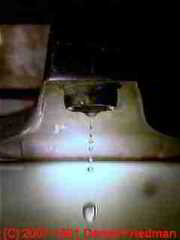 The US EPA estimates that one in ten homes has leaks wasting 90 or more gallons of water a day, that the average household's leaks can account for more than 10,000 gallons of water wasted every year, and that household leaks in the United States alone waste more than a trillion gallons of water a year - enough to supply over eleven million homes. - U.S. EPA (2014)
The US EPA estimates that one in ten homes has leaks wasting 90 or more gallons of water a day, that the average household's leaks can account for more than 10,000 gallons of water wasted every year, and that household leaks in the United States alone waste more than a trillion gallons of water a year - enough to supply over eleven million homes. - U.S. EPA (2014)
Find plumbing & heating leaks by these easy methods:
- Listen for plumbing supply or drain or pump noises
when you think nobody is using any plumbing fixtures in the home. For a building served by a private water pump & well or even one using municipal water with a pressure booster pump listen for unexpected cycles of water pump operation. See these diagnostic procedures: - Look for wet surfaces
in sinks, tubs, beneath showers, for example in the sink basin when no one has been using the fixture for a time. A subtle drip may be the cause. - Look for stains
in toilet bowls or sinks or tubs, particularly stains beneath faucets in sinks or under the rim at toilets. Running water may be subtle, especially in a toilet with a small leak at the flush valve or flapper. But mineral deposits or stains are a great clue.
We may use septic dye or food coloring in the toilet tank to help watch for water flowing from the tank into the bowl. - Look at the water meter
if you are connected to a municipal supply. If you think nobody is using any plumbing fixtures you should see no movement in the water meter. Or note the water meter reading when you are about to go to sleep and check it again in the morning. - Look at and beneath relief valves
on water heaters and heating boilers for signs of dripping; And look at the area around water storage tanks, water heater tanks and boilers for signs of leaks.
See RELIEF VALVE LEAKS - See LEAK TYPES, WATER SUPPLY or DRAIN PIPES for an explanation of some of the more subtle types of water piping leaks such as leaks at a shower control that leak into the wall but only when the shower valve is open.
Inspect & Repair or Upgrade these Points of Water Leaks or Unnecessary Water Use
- Water pressure regulator adjustment:
If your building uses a water pressure regulator, reduce the system pressure setting to a lower but still functional level and you will see a dramatic savings in water usage at no cost whatsoever except the brief effort to adjust that device.
See details at WATER PRESSURE REGULATOR ADJUSTMENT - Dishwashers
that save water are available from major appliance brands including Bosch, KitchenAid and Whirlpool. And using a dishwasher will usually save a considerable amount of water compared with washing dishes by hand.
A standard dishwasher uses about six gallons of water per cycle, an Energy-Star rated dishwasher cuts this to four gallons per cycle.
Meanwhile Bosch's 800-Plus water saving dishwasher uses "as little as" just 1.5 gallons of water. [Additional appliance energy savings are available besides water conservation.]
In contrast, running a kitchen sink faucet for just two minutes will typically use eight-to ten gallons. (While "average faucet flow rates" are sometimes given as 2 gpm, we have measured the flow rates at several thousand kitchens, bath sinks, showers and tubs: the flow rate at a kitchen sink is more often around 4 gpm.)
And I'm doubtful that you run the kitchen sink faucet for just 120 seconds to wash an evening meal's worth of dirty dishes. - Faucets that drip:
repairing leaky faucets can significantly reduce water waste. Inspect your building for dripping faucets both inside and at outside hose bibbs.
See FAUCETS, OUTDOOR HOSE BIBBS how to spot & fix leaks at outdoor faucets & hose bibbs.
Often a leak around the hose bibb (or sill cock) faucet shaft can be stopped simply by gently tightening the cap nut to compress the faucet stem packing. While you're at it, repair or replace those garden hose connectors that leak water continuously while a garden hose is in use. Often all that's needed is a hose washer.
Sink and tub faucets may also drip if building water pressure is abnormally high - say over 70 psi.
See WATER PRESSURE REGULATOR ADJUSTMENT - Faucets that discharge air:
may be due to well piping leaks. A piping can let air into the system in some conditions while at different times it may be leaking water out. See AIR DISCHARGE at FAUCETS, FIXTURES - Heating system leaks:
More subtle leaks that waste water can be more tricky to spot: for example a leaky tankless coil leaks into the heating boiler - a problem that may show up as drips or as heating boiler RELIEF VALVE LEAKS - a situation that is both wasting water and is dangerous.
See BOILER LEAKS, HOW TO LOCATE for details. - Install low-flow shower heads & faucet strainers.
These parts are inexpensive and unless your old fixtures are corroded to near-death, the new parts should be a simple screw-on replacement. - Install flow control valves
to reduce the gallon-per-minute flow rate at showers, sinks, and irrigation systems. We describe types of flow control valves at FLOW CONTROL VALVES - Irrigation & watering system leaks
are an example of covert water waste: often the leak is underground where you don't see it, or perhaps we reason: heck we're watering, right? What's a little leak? But not only are you not delivering the water to its needed location, your irrigation system may be wasting more water than one would imagine.
The US EPA estimages that ... an irrigation system that has a leak 1/32nd of an inch in diameter (about the thickness of a dime) can waste about 6,300 gallons of water per month. - (EPA 2014)
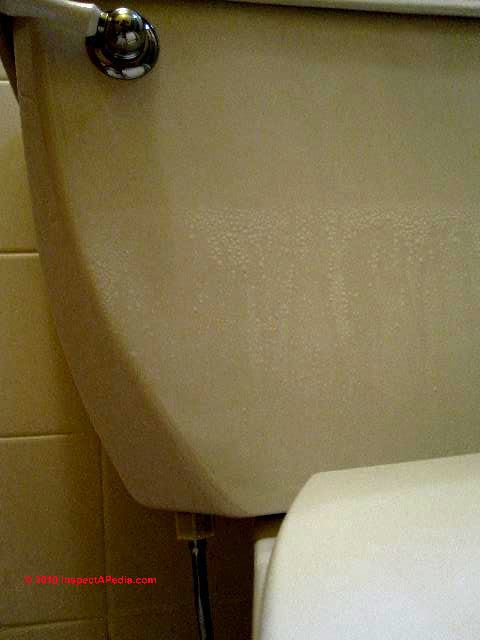
- Toilets that run:
running toilets waste enormous water volumes, can flood and damage a septic soakaway bed or drainfield, and in freezing climates can lead to ice-blocked main drains and sewage backups. See these diagnosis and repair articles for leaky or running toilets:
Photo: condensate on this toilet tank may be a clue that the toilet is running continuously.- TOILET RUNS CONTINUOUSLY - How to diagnose and fix running toilets and fix toilet noises.
A running toilet can ruin a septic drainfield by flooding it. his article includes diagnostic photos that can help you spot a toilet that is running silently - without notice.
Look for stains in the toilet bowl or in humid weather, look for condensation on the toilet tank such as that shown in our photo above. - Toilet flush valves
or toilet fill valves that do not operate properly may cause a toilet to flush poorly, but a more common defect is a leaky tank flapper or flush valve that allows the toilet to run constantly.
The inspection and repair of these devices at TOILET REPAIR GUIDE describes the repair of toilets that do not flush properly.
Usually this is a trivial repair, possibly simply an adjustment of the flush valve components inside the toilet tank. - TOILET FLUSHOMETER VALVES provide flush-cycle water for toilets that do not use a traditional gravity-operated flush tank.
Particularly because they normally operate at high water pressures and send a significant water volume into the toilet, a flushometer valve that is not properly adjusted or that a flushometer valve that allows a toilet to run constantly can waste an enormous volume of water.
Flushometer valve flow & flush quantity adjustment:
the flush volume is adjusted on most flushometer valves by turning the control stop, turning the flush volume adjustment screw, or by replacing an internal piston that determines the maximum flush volume.
Piston changes can drop a 13 liter flush volume down to about 6L!. For details see the City of Toronto's excellent Flushometer test report (2005) listed atReferences or Citations .
- TOILET RUNS CONTINUOUSLY - How to diagnose and fix running toilets and fix toilet noises.
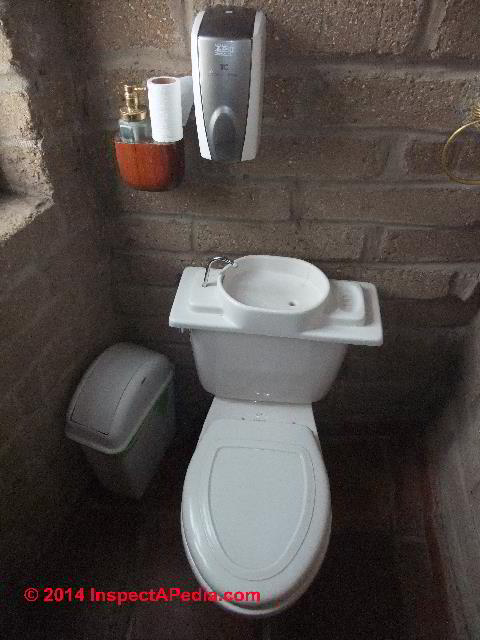
- Water Conserving Toilets or Low Flush Toilets
conserve water by using only a small amount of water to achieve the flush cycle. Low-Water or Low-Flush toilets work well partnered with graywater systems to both conserve and re-use water.
The neat water-reusing toilet shown here combines a sink for hand-washing with the toilet flush tank. Details about using graywater to flush toilets are at
GREYWATER FLUSH TOILETS.
Water used to wash one's hands is directly recycled into the toilet flush tank for the next toilet use. This Stilfor toilet uses 1.6 gallons of recycled water per flush.
See FLUSHOMETER TOILETS & URINALS where we discuss waterless urinals
Also see ALTERNATIVE & WATERLESS TOILETS for this and similar water saving toilets & accessories including
The CINDERELLA INCINERATING TOILET - and related products - Well piping system leaks:
leaks in the well casing or well piping can be subtle and thus hard to spot, but can waste tremendous amounts of water, reduce building water flow rate or water quantity, and can introduce air or debris into the water supply.
Some well piping leaks are truly clandestine, leaking water underground where you will never see it.
See WELL PIPING LEAK DIAGNOSIS for a complete guide to well piping leaks.
Watch out: if you have either of these problems, WATER PUMP SHORT CYCLING
or WATER PUMP WONT STOP RUNNING the underlying cause could be a leak in well piping that is losing water underground. - PLANTING & LANDSCAPING to CONSERVE WATER - water conservation with respect to watering lawns
- Rainwater Collection Systems
provide alternative water supply for use in flushing toilets or irrigating crops, lawns, or plants.
Rainwater collection relieves the load on the potable water supply whether it's from a local well or from municipal supply piping. Rainwater collection systems range from a simple "rain barrel" to collect roof runoff, to very large cisterns which store water for onsite use during dry seasons or droughts.
Examples are at PASSIVE SOLAR HOME, LOW COST. - Septic system water conservation:
even conventional drainfields, may provide moisture for lawns and certain other plants, but planting over a septic drainfield can also destroy it . See- DRIP DISPERSAL SEPTIC EFFLUENT SYSTEMS
- (Jantrania/Gross wastewater system type III or if treated to level 2 or better effluent, Jantrania/Gross wastewater system type VII). Drip dispersal systems may include pressure dosing or systems that dispose of effluent using only gravity. - PLANTS & TREES OVER SEPTIC SYSTEMS trees, shrubs, gardens, groundcover over or near the septic system: what can you plant over or near septic system components without causing a problem?
TREATMENT LEVELS describes the different levels of treatment of septic wastewater that occur in typical residential systems.
Highly-treated (95% or better) septic effluent produced by some aerobic septic systems can be sprayed directly onto a lawn surface for watering grass. - See AEROBIC SEPTIC SYSTEMS, ATUs.
We do not recommend distribution of conventional septic system (tank and drainfield) minimally-treated septic effluent (less than 95%) onto gardens or orchards producing food products without first checking with your local health department.
- DRIP DISPERSAL SEPTIC EFFLUENT SYSTEMS
- Site contouring, landscaping, water runoff control
are used to slow the movement of rainwater over hard or rocky soils to allow time for water to soak into the ground where it both nourishes plants and may also replenish the local aquifer feeding local wells.
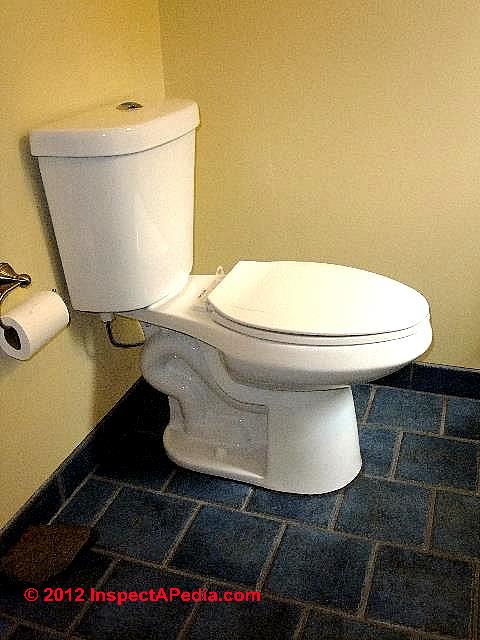
- Toilet flush water quantity improvements: low-flush toilets or water saving use improved flush design, improved bowl design, and in some cases power flushing systems to clean the bowl while using less water than a standard toilet. In most homes changing from a conventional flush toilet to a water-conserving toilet is a "bolt-in" repair: the new toilet mounts in the same location and uses the same plumbing connections as the less efficient toilet that it replaces.
At TOILET TYPES, CONTROLS, PARTS we discuss the top flush Glacier Bay water saving toilet installed in the bathroom of our lab and shown in the two photos above. - Toilet flush water quantity & bowl filling quantity: after fixing toilets that run (earlier in this list) try the following toilet tune-ups:
- Check that the toilet bowl overflow fill tube [image] is properly connected in the toilet tank. During toilet flush tank re-fill the toilet bowl fill tube directs water down the toilet tank overflow/standpipe to assure that there is adequate water volume in the bowl itself. If the toilet bowl water level is too low, the toilet will flush poorly.
- Check that the toilet tank fill level is correct: the toilet tank fill valve should cut off water entry into the tank when water reaches the "flush level" or "water level" line marked on the toilet tank interior.
- Try reducing the toilet tank fill volume without adjusting the fill valve itself; rather we just put a brick or a water-filled plastic bottle inside the toilet tank to take up some space.
On older toilets that use more than 3 gallons per flush, provided you keep the proper water level in the toilet bowl, you can probably reduce the flush volume to about 3 gallons. - Alternative methods of reducing the toilet tank flush volume include a baffle installed around the tank flapper valve and adjustable toilet tank flapper valves
(Adjustable toilet tank flapper valves are sold by Fluidmaster, Korky, Lavelle, and Plumb Pak/Keeney and are widely available at plumbing suppliers & building supply stores). Photos of a toilet tank baffle and other toilet tank valves, controls, and parts are
at TOILET TYPES, CONTROLS, PARTS - The Sloan Flushmate® discussed at TOILET TYPES, CONTROLS, PARTS combines air pressure and water pressure to provide a "power flush" that uses a siphon jet design to combine water savings with improved drain performance. The company's Flushmate® IV model toilet uses less than 1 gallon (4 liters) per flush for a 45% water usage savings compared with a traditional gravity-flush tank type toilet.
- WATERLESS TOILETS and waterless urinals conserve water by using no water to operate the toilet flush cycle. Waterless toilets include incinerating toilet models, composting toilets, chemical toilets and similar systems. Waterless toilets work well with graywater systems to conserve water. This article lists the full range of toilet types & water usage levels
Waterless toilets include incinerating toilet models (see links listed at the ARTICLE INDEX the bottom of this article for more about alternative toilet products & designs.) - INCINERATOR TOILET SYSTEMS: incinerator toilets use electricity or gas to burn the waste placed into these systems. Like chemical toilets and holding tanks they have limited capacity, are used where water is not available or must be conserved, and they do not address the handling of remaining graywater from sinks and showers.
My favorite of this type was the "Destroylet" incinerator toilet which was electric/propane fueled and which is no longer on the market. Each flush resulted in a more than 10-minute burn cycle which produced a pretty smelly exhaust. - OUTHOUSES & LATRINES - Outhouses, or latrines or simple trench systems, useful in remote and impoverished areas to improve sanitation and thus the quality of drinking water and other special, extremely low-cost waste handling, wastewater treatment systems are ignored by most modern texts on onsite wastewater treatment, excepting perhaps military manuals which address field toilets and sanitation for military operations.
This topic needs considerably more attention as a step in assisting rural, poor areas in developing nations.
Above: the dual water usage choices in this Glacier Bay top flush toilet offer an additional step to reduce water consumption.
- Water heater size and water heater efficiency
- ALTERNATIVE HOT WATER SOURCES
- GAS HEATERS, HIGH EFFICIENCY
- HOT WATER EFFICIENCY IMPROVEMENT
- TANKLESS WATER HEATERS
- WATER HEATER SIZE SPECIFICATION - daily hot water usage rates & tables
- Washing machines that conserve water. Clothes washers that use very little water and that actually wash clothes cleaner than their older brothers and sisters are provided by most major appliance manufacturers.
And there are some interesting hybrid ideas:
- Smeg, an Italian company produces both sink top over a clothes washer and a sink top over a refrigerator! Smeg S.p.A Via Leonardo da Vinci, 4 42016 Guastalla (RE), ITALY Tel. +39 0522 821 1 Fax +39 0522 821 452 smeg@smeg.it, Website http://www.smeg.com
- WATER FLOW RATE CALCULATE or MEASURE describes the actual measurement as well as calculation of water usage, flow rates, water metering, and it describes methods of controlling water usage thorugh metering and flow controls.
- WATER USAGE REQUIREMENTS provides a table of daily residential water usage.
- WINTERIZE A BUILDING - includes suggstion's to avoid frozen, burst pipes and consequent leaks and building water damage
Ways to re-use water: graywater systems, water re-use approaches
- AEROBIC SEPTIC SYSTEMS, ATUs - in some designs produce wastewater effluent that is sufficiently sanitary to use for lawn irrigation. Those aerobic systems actually depend on evaporation and surface distribution for final disposal of treated wastewater.
- Filters for Greywater are installed at a laundry sink, clothes washer, or at the outlet of a wastewater tank to filter water for re-use. See FILTERS SEPTIC & GREYWATER to protect septic drainfields and reduce drainfield clogging
- Graywater Irrigation Systems or drip irrigation systems make use of (usually filtered) greywater to provide water to lawns, plants, or crops.
- GREYWATER SYSTEMS - discusses how to install & use graywater systems to conserve water or relieve septic system wastewater loading by using a greywater distribution or greywater diversion system.
An example of a packaged grey water system is the Aqua2use greywater system [reviewer link] that is described by Water Wise Group, its distributor in the U.S., as the "most efficient and advanced greywater diversion device available".
Image at left of the Aqua2Use system interior components is used with permission from Water Wise Group.
Here is an exterior view [image] and here is a sketch of how this system works.A typical greywater diversion system provides a greywater receiving filter-tank or pumping chamber, a cascade of greywater filter materials and greywater pump itself, perhaps with integrated controls that operate the pump.
- FILTERS SEPTIC & GREYWATER for graywater filters used to protect septic systems from debris in graywater, the first step in making graywater useful for watering grass, trees, plants, etc.
- GREYWATER SYSTEM BOOKS for books on graywater systems
Ways to store rainwater, graywater, or water from other sources for use or re-use, with or without treatment and filtering as needled

- CISTERNS, WATER STORAGE are water storage systems that can be used to store water from seasonal rainstorms or from other sources for later re-use. "Rain barrels" are mini-cisterns that are placed at the ends of downspouts.
Cisterns are much larger containers, closed or open-topped, and located above-ground or under-ground. Cisterns or rain tanks are often designed to contain several thousand gallons of water at residential properties. - WATER TANK TYPES: WATER, OIL, EXPANSION, ALL discusses types & sizes of water storage tanks. See
- CAPTIVE AIR TANKS
- PLASTIC RECYCLING CODES, TANKS, TYPES
- PLASTIC & FIBERGLASS TANKS, HDPE
- RAINWATER STORAGE TANKS
- REPLACEMENT WATER TANKS
- STEEL WATER TANKS
- WATER PRESSURE BOOSTING
- WATER PRESSURE TANKS, BLADDER TYPE
- WATER PRESSURE TANKS, FIBERGLASS
- WATER PRESSURE TANKS, STEEL
- WATER PUMP & TANK I&O & REPAIR MANUALS
- WATER STORAGE TANKS, GROUND LEVEL
- WATER STORAGE TANKS, LARGE
- WATER STORAGE TANKS, OPEN
- WATER STORAGE TANKS, ROOFTOP
Ways to find more water for storage or use at your home or other facility
- Diagnostic guides for water wells that are not producing enough water
- FOOT VALVES - a leaky foot valve can lead to loss of well pump prime and loss of water pressure
- WATER PUMPS, TANKS, TESTS, WELLS, REPAIRS - home
- WATER PUMP CAPACITIES TYPES RATES GPM
- WELL DEPTH, HOW TO MEASURE
- WELL DEPTH, HOW TO MEASURE FAQs
- WELL FLOW RATE - the well flow rate: how much water is in the well, how much water do we have available, how to get more water from the well. How do we find out well water quantity - well flow rates or draw down tests- well flow rates or draw down tests. How long will the water well last? What is the well recovery rate?
- WELL FLOW TEST for WATER QUANTITY - how do we actually conduct a well flow rate or yield test?
- WELL LIFE EXPECTANCY - how long should a well last & what factors affect well life?
- WELL PIPING LEAK DIAGNOSIS - a leak in the water piping anywhere between the well bottom and the building can wreak havoc, waste water, and burn up the pump or controls
- WELL FLOW TEST PROCEDURE how can a homeowner or home buyer make a simple well water quantity test
- WELL YIELD, SAFE LIMITS - defined by sum of static head plus flow rate & other measures
- WELL WATER PRESSURE DIAGNOSIS - how to troubleshoot bad water pressure
- WELL YIELD DEFINITION - how much water can we get out of the well over what time period at what flow rate
- WELL YIELD IMPROVEMENT - how to get more water from the well, how to improve well water yield - steps to try before drilling a new well
- WELLS CISTERNS & SPRINGS - home: what are the different types of wells, how are wells constructed, installed, diagnosed, repaired.
- DRINKING WATER EMERGENCY SOURCES discusses emergency sources of drinking water, such as how to find potable water in a disaster area after flooding, a hurricane, fire, or earthquake.
- DRINKING WATER - EMERGENCY PURIFICATION discusses alternative ways to obtain safe drinking water in an emergency
- Rainwater Collection & storage systems are also described
at PASSIVE SOLAR HOME, LOW COST - Site contouring, landscaping, water runoff control
are used to slow the movement of rainwater over hard or rocky soils to allow time for water to soak into the ground where it both nourishes plants and may also replenish the local aquifer feeding local wells. Site contouring not only preserves soils in place and allows rainwater to soak into soils, it may also be used (in the form of a swale or intercept drain) to capture surface runoff for storage in stock ponds or even cisterns. - WATER SOURCE ALTERNATIVES - comparison of sources of water for household or garden use besides wells or municipal water supply: rainwater collection, water condensation systems. Green-water / graywater / cisterns / rainwater collection systems
- WELLS CISTERNS & SPRINGS - home
Also see these tables of daily and peak water and hot water quantity and usage:
- HOT WATER QUANTITY DAILY USE
- HOT WATER PEAK DEMAND USE
- PLUMBING DRAIN FIXTURE UNITS DFUs - measure of the wastewater volume or loading of a drain waste or vent system
- SEWAGE FLOW & DESIGN FLOW ESTIMATES - plumbing fixture flow rates
- WATER QUANTITY USAGE TABLES
...
Continue reading at WATER SOURCE ALTERNATIVES or select a topic from the closely-related articles below, or see the complete ARTICLE INDEX.
Or see these
Recommended Articles
- WATER CONSERVATION MEASURES - home
- ALTERNATIVE & WATERLESS TOILETS
- CISTERNS, WATER STORAGE
- DRINKING WATER - EMERGENCY PURIFICATION
- DRINKING WATER EMERGENCY SOURCES
- FLOW CONTROL VALVES
- GREYWATER CODES & REGULATIONS
- GREYWATER FLUSH TOILETS
- GREYWATER SYSTEMS - home
- GREYWATER SYSTEM PRODUCTS, SUPPLIERS
- LEAK TYPES, WATER SUPPLY or DRAIN PIPES
- PLANTING & LANDSCAPING to CONSERVE WATER
- GREYWATER RE-USE & RAINWATER COLLECTION SYSTEMS
- SPRINGS as WATER SUPPLY
- TOILET RUNS CONTINUOUSLY
- WATER METERS, RESIDENTIAL
- WATER PRESSURE REGULATOR ADJUSTMENT
- WATER FLOW RATE CALCULATE or MEASURE
- WATER PUMP WONT STOP RUNNING
- WATER QUANTITY IMPROVEMENT
- WATER SOURCE ALTERNATIVES
- WATER STORAGE TANKS, LARGE
- WATER USAGE REQUIREMENTS
- WELL FLOW TEST PROCEDURE
- WELL PIPING LEAK DIAGNOSIS
- WELL YIELD IMPROVEMENT
- WELLS CISTERNS & SPRINGS - home
Suggested citation for this web page
WATER CONSERVATION MEASURES at InspectApedia.com - online encyclopedia of building & environmental inspection, testing, diagnosis, repair, & problem prevention advice.
Or see this
INDEX to RELATED ARTICLES: ARTICLE INDEX to WATER SUPPLY, PUMPS TANKS WELLS
Or use the SEARCH BOX found below to Ask a Question or Search InspectApedia
Ask a Question or Search InspectApedia
Try the search box just below, or if you prefer, post a question or comment in the Comments box below and we will respond promptly.
Search the InspectApedia website
Note: appearance of your Comment below may be delayed: if your comment contains an image, photograph, web link, or text that looks to the software as if it might be a web link, your posting will appear after it has been approved by a moderator. Apologies for the delay.
Only one image can be added per comment but you can post as many comments, and therefore images, as you like.
You will not receive a notification when a response to your question has been posted.
Please bookmark this page to make it easy for you to check back for our response.
IF above you see "Comment Form is loading comments..." then COMMENT BOX - countable.ca / bawkbox.com IS NOT WORKING.
In any case you are welcome to send an email directly to us at InspectApedia.com at editor@inspectApedia.com
We'll reply to you directly. Please help us help you by noting, in your email, the URL of the InspectApedia page where you wanted to comment.
Citations & References
In addition to any citations in the article above, a full list is available on request.
- "Ground Water", U.S. EPA, U.S. Environmental Protection Agency, Office of Water Resource Center, 1200 Pennsylvania Avenue, NW Ariel Rios Building Washington, DC 20460 Tel: (202) 260-7786retrieved 2/3/13, original source: http://water.epa.gov/type/groundwater/
- "Drinking Water from Household Wells", U.S. EPA, (2003), retrieved 2/3/13, original source: http://water.epa.gov/drink/info/well/upload/ 2003_06_03_privatewells_pdfs_household_wells.pdf
- Adam Nagourney, Ian Lovett, "Lack of Water Has U.S. West Fearing Worst", The New York Times, 2 February 2014, p. 1, 16
- "Water Well Drilling in the US: Market Research Report", Water Well Drilling Market Research Report, NAICS 23581, Aug 2013, Website: http://www.ibisworld.com/industry/?indid=202 retrieved 2/3/2014 - Abstract quotation
Key downstream construction markets dictate a lot of demand for water well drilling, so as residential and non-residential construction picks up as the economy recovers, industry services will be needed.
In the housing market, demand for water well drilling and groundwater connections will be stimulated by the pent-up demand for new housing settlements.
At the same time, industry revenue growth will be marginally contained by continued improvements in water use efficiency, particularly in the agricultural and industrial markets ...
Hosting more than 15.9 million wells, the United States is the second-largest well water market in the world, after India. The National Ground Water Association estimates that 44.0% of the US population is dependent on groundwater for its drinking water supply.
In fact, private residential wells make up the largest share of all water wells in the country, while irrigation accounts for the greatest total use of groundwater.
Other types of wells are used for municipal systems, industrial processes, geothermal energy and groundwater level and quality monitoring. - National Sanitation Foundation P .O. Box 130140 789 N Dixboro Road Ann Arbor, MI 48113-0140 (734) 769-8010, (800) NSF-MARK www.nsf.org
- Veritec Consulting, Inc., "Testing of Popular Flushometer Valve/Bowl Combinations, Final Report, Prepared for City of Toronto with Region of Durham & Region of Waterloo Revised August 2005", Veritec Consulting Inc., 1495 Bonhill Rd., Unit #12, Mississauga, ON L5T 1M2, P: (905) 696-9391, ext. 102, Email: bill@veritec.ca, (2005), retrieved 2/3/2014, original source: http://www.cwwa.ca/pdf_files/fv%20revised%20final%20report%20aug,23.pdf
- "Water Sense, Fix a Leak Week", U.S. Environmental Protection Agency, retrieved 2/2/2014, original source: http://www.epa.gov/WaterSense/pubs/fixleak.html
- Water Quality Association, P.O. Box 606, 4151 Naperville Road, Lisle, IL 60532 Website: www.wqa.org
- National Groundwater Association (NGWA), National Ground Water Association, 601 Dempsey Rd., Westerville, OH 43081 USA, Tel: 800 551.7379 (614 898.7791 outside the United States), Email: ngwa@ngwa.org, Website: http://www.ngwa.org. Quoting: NGWA is the leading groundwater association that advocates for the responsible development, management, and use of water.
- "Groundwater Sustainability", [Position paper] (6/19/2013) National Groundwater Association (NGWA), National Ground Water Association, 601 Dempsey Rd., Westerville, OH 43081 USA, Tel: 800 551.7379 (614 898.7791 outside the United States), Email: ngwa@ngwa.org, Website: http://www.ngwa.org. Retrieved 2/3/14, original source http://www.ngwa.org/Documents/PositionPapers/GW%20Sustainability.pdf
- In addition to citations & references found in this article, see the research citations given at the end of the related articles found at our suggested
CONTINUE READING or RECOMMENDED ARTICLES.
- Carson, Dunlop & Associates Ltd., 120 Carlton Street Suite 407, Toronto ON M5A 4K2. Tel: (416) 964-9415 1-800-268-7070 Email: info@carsondunlop.com. Alan Carson is a past president of ASHI, the American Society of Home Inspectors.
Thanks to Alan Carson and Bob Dunlop, for permission for InspectAPedia to use text excerpts from The HOME REFERENCE BOOK - the Encyclopedia of Homes and to use illustrations from The ILLUSTRATED HOME .
Carson Dunlop Associates provides extensive home inspection education and report writing material. In gratitude we provide links to tsome Carson Dunlop Associates products and services.



